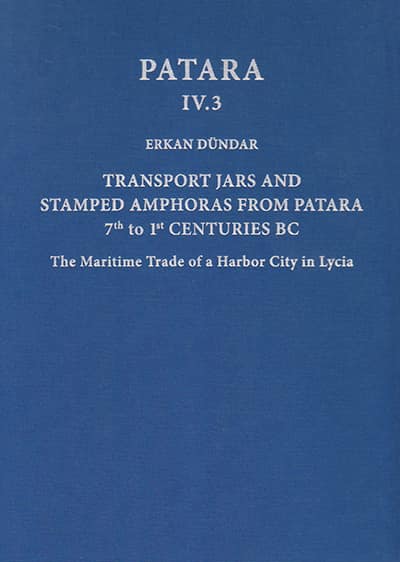Patara IV.3
Transport Jars and Stamped Amphoras from Patara, 7th to 1st Centuries BC - The Maritime Trade of a Harbor City in Lycia
489 pp, b/w and colour figures, 25 plates, hb, in English.
CONTENTS
SERIES EDITOR’S FOREWORD
PREFACE
FOREWORD AND ACKNOWLEDGEMENTS
BIBLIOGRAPHY
ABBREVIATIONS
INTRODUCTION
I. GENERAL OVERVIEW OF THE POLITICAL AND COMMERCIAL DEVELOPMENT OF THE CITY
1. Political Outline
2. Commercial Development
II. THE ROLE OF AMPHORAS IN ANCIENT COMMERCE
III. COMMERCIAL AMPHORAS RECOVERED AT PATARA
1. Chian Amphoras
2. Clazomenian Amphoras
3. Lesbian Amphoras
4. Samian Amphoras
5. Ionia.ß (Zeest-Samos) Amphoras
6. Corinthian/Corcyrean Amphoras
7. Thasian Amphoras
8. Mendean Amphoras
9. Coan Amphoras
10. Lycian Amphoras
11. Knidian Amphoras
12. Rhodian Amphoras
13. Amphoras Produced in the Rhodian Peraia
13.1. Hieroteles Group
13.2. Band-Rimmed Amphoras
14. South Aegean Mushroom-Rimmed Amphoras
15. Nikandros Group
16. Cypriot Amphoras
17. Unidentified Amphoras
IV. GENERAL CONCLUSIONS REGARDING THE COMMERCIAL AMPHORA ASSEMBLAGES
V. STAMPED AMPHORA HANDLES AT PATARA AND THEIR SIGNIFICANCE
1. Rhodes
1.1. Eponyms
1.1.1. Period I (ca. 304 – 235 BC)
1.1.2. Period II (ca. 234 – 199 BC)
1.1.3. Period III (ca. 198 – 161 BC)
1.1.4. Period IV (ca. 160 – 146 BC)
1.1.5. Period V (ca. 145 – 108 BC)
1.1.6. Period VI (ca. 107 – 88/86 BC)
1.1.7. Period VII (ca. 85–40/Augustus BC)
1.2. Fabricants
1.2.1. Period I (ca. 304 – 235 BC)
1.2.2. Period II (ca. 234 – 199 BC)
1.2.3. Period III (ca.198 – 161 BC)
1.2.4. Period IV (ca. 160 – 146 BC)
1.2.5. Period V (ca. 145 – 108 BC)
1.2.6. Period VI–VII (ca. 107–88/86 BC – Augustus)
1.3. Illegible Stamps
2. Rhodian Peraia
2.1. Eponyms
2.2. Fabricants
2.3. Illegible stamps
3. Knidos
3.1. Period I–II (ca. 325 – 220 BC)
3.2. Period III (ca. 219 – 188 BC)
3.3. Period IV (ca. 187 – 146 BC)
3.4. Period V (ca. 145 – 108 BC)
3.5. Period VI (ca. 107 – 78 BC)
3.6. Period VII (ca. 77 – 30 BC)
3.7. Illegible stamps
4. Cyprus
5. Thasos
6. Cos
7. Chios
8. Nikandros
9. Parmeniskos
10. Unclassified Stamps
VI. ASSESSMENT OF THE STAMPED AMPHORA HANDLES
VII. CHRONOLOGICAL SUMMARY FOR THE AMPHORA REMAINS AT PATARA
1. 7th – 6th centuries BC
2. 5th – 4th centuries BC
3. 3rd – 1st centuries BC
4. Lycia’s Place in Ancient Mediterranean Sea Trade as Seen Through Amphoras
VIII. ARCHAEOMETRIC ANALYSIS OF THE AMPHORAS
Introduction
1. Archaeometric Analyses
1.1. Sampling and Documentation
1.2. Chromametric Analysis
1.3. Thin Section Optical Microscope Analysis
1.4. X-Ray Fluorescence Analysis
2. Evaluation of the Chemical Analysis Results of the Amphora and Soil Samples through Cluster Analysis
2.1. Soil Samples
2.2. Amphora Samples
2.3. Grouping of Amphora Samples with Soil Samples
3. General Archaeological Evaluations and Comparisons in Amphora Samples
IX. ÖZET
1. Yöntem
2. Patara Amphora Buluntulari İçin Kronolojik Bir Özet
2.1. MÖ 7 ve 6. Yüzyıllar
2.2. MÖ 5 ve 4. Yüzyıllar
2.3. MÖ 3 ve 1. Yüzyıllar
3. Amphora Verileri Işığında Likya’nın Antik Akdeniz Deniz Ticaretindeki Yeri
CATALOGUE
INDEX
?PLATES




